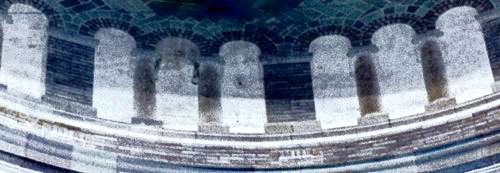![]()

![]()
Sound and Technology from the Artist's Perspective
![]()
011500.02

When we watch television we don't listen to the radio. When we fax a message we don't write a letter. When we type a letter, we don't write the letter by hand. When we e-mail a message we don't speak on the telephone. When we listen to an audio CD we don't attend a concert. Because we do the former, we are not engaged in the latter. In each case we have created a negative space of technology, through use of current technology. Notice that the content may stay relatively, but not exactly, the same. Usually we give a thought to the medium for which the message is prepared and then make appropriate adjustments.
The negative space, the new blank, the nothingness that has been created by use of the new technology exists only through the disuse of the older technology which may still be available. We can write letters by hand, listen to radio, speak on the phone, attend a concert. But a problem occurs if we stop noting that former technologies may have had unique capacities that the newer technology has in some way compressed, speeded up or otherwise transformed. A hand-written letter conveys a personal sense, touch and object quality that is not available in e-mail. This is where the true blank occurs. With music this is a crucial aspect. If this negative space is induced by a current technology, the subtext of the former technology itself becomes a critical issue.
The Twentieth Century saw remarkable gains in subsequent generations of recording and music production technologies, each in some way outstripping the previous in playback capacity, ease of use or fidelity: wax cylinders, generations of rotating vinyl discs, magnetic tape, stereo, various surround sound formats and the plethora of digital audio formats available today. While one could often argue the relative losses and gains at different steps of the technology curve in audio, it has generally been accepted that these were primarily methods of documentation, that they didn't strive to replace live performance (excluding MIDI and the last thirty years or so of synthesized and sampled music production). However, 'canned' sound did find a huge market, particularly in personal use, radio, television , film and increasingly on the internet. Recording technologies contributed to this current state of saturation. The unintended results: ubiquitous recorded music playback significantly diminishes the singular impact of live music.
Generations born (nearly everyone today) to recorded music playback as a way of life are removed from this aspect of live music. We have never not had recorded media. The complete impact of the negative space created between live performance and recorded media is now historical, or at best available only among the remaining isolated tribal peoples of the world... in other words, most simply don't know what it was like to hear music only live, with no other alternatives available. We are on the other side of a negative space of technology which only imagination can fill.
Copyright © 15 January 2000 by Jeff Talman, Saratoga Springs, NY, USA
![]()